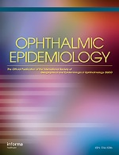
OPHTHALMIC EPIDEMIOLOGY
Scope & Guideline
Transforming Research into Visionary Solutions
Introduction
Aims and Scopes
- Epidemiological Studies:
Research exploring the prevalence, incidence, and risk factors associated with various eye diseases and conditions in different populations. - Public Health and Policy:
Investigations into the impact of public health initiatives, healthcare policies, and socioeconomic factors on eye health outcomes. - Technological Innovations in Ophthalmology:
Studies evaluating the role of emerging technologies, including artificial intelligence and telemedicine, in improving ophthalmic care and patient outcomes. - Sociomedical Factors in Eye Health:
Examinations of the social determinants of health affecting vision care access, utilization, and outcomes, particularly in underserved populations. - Clinical Trials and Interventions:
Reports on clinical trials assessing the effectiveness of treatments and interventions for various ophthalmic conditions. - Global Perspectives on Eye Health:
Research highlighting disparities and challenges in eye health across different geographic and socioeconomic contexts.
Trending and Emerging
- Impact of COVID-19 on Eye Health:
An increasing number of studies are investigating the effects of the COVID-19 pandemic on eye health services, patient outcomes, and the psychological impact of vision impairment during the pandemic. - Artificial Intelligence in Ophthalmology:
There is a notable rise in research focused on the application of artificial intelligence for diagnostics, treatment planning, and improving access to eye care services. - Social Determinants of Eye Health:
Emerging studies are increasingly addressing how socioeconomic factors, including access to healthcare, education, and community resources, influence eye health outcomes. - Systematic Reviews and Meta-Analyses:
An uptick in systematic reviews and meta-analyses reflects a trend towards synthesizing existing research to provide clearer insights into broad ophthalmological issues. - Myopia and its Risk Factors:
Research on myopia prevalence and its associated risk factors, particularly in children, is gaining traction, reflecting global concerns about increasing rates of myopia. - Vision Care Disparities:
Emerging themes focus on disparities in eye care access and outcomes among various demographic groups, highlighting the need for targeted interventions.
Declining or Waning
- Trachoma Studies:
Research focused on trachoma prevalence and elimination strategies has decreased, possibly due to progress in controlling the disease in certain regions. - Traditional Surgical Outcomes:
With advancements in minimally invasive techniques and new technologies, traditional surgical outcome studies are appearing less frequently. - Single-Country Focused Studies:
There has been a reduction in studies focusing solely on eye health issues within single countries, as there is a growing trend toward comparative and multinational research. - General Ophthalmic Trauma Research:
While still important, general studies on ophthalmic trauma are less common, possibly overshadowed by more specific inquiries into trauma related to particular events like sports or military service. - Historical Epidemiology of Eye Diseases:
Research examining historical trends in eye diseases may be waning, with a shift towards contemporary studies that inform current public health strategies.
Similar Journals

Nepalese Journal of Ophthalmology
Advancing Eye Health Through Innovative ResearchNepalese Journal of Ophthalmology, established by the NEPAL OPHTHALMIC SOC, is a premier Open Access journal dedicated to advancing the field of ophthalmology. With its ISSN 2072-6805 and E-ISSN 2091-0320, the journal provides an important platform for sharing innovative research and clinical findings in eye health. Since its inception in 2009, the journal has aimed to disseminate high-quality research that addresses contemporary challenges in ophthalmic practices, thus supporting improved patient care and outcomes within Nepal and beyond. The journal has achieved notable recognition, evidenced by its Scopus rank of #267 out of 915 in the field of General Medicine, placing it within the 70th percentile. Researchers, professionals, and students will find valuable information in its comprehensive articles, which cater to a multidisciplinary audience interested in the latest developments in ophthalmology. Emphasizing accessibility, the journal ensures that all published content is freely available, fostering collaboration and knowledge sharing in the global medical community.

BMC Ophthalmology
Elevating the Standards of Ophthalmic ResearchBMC Ophthalmology is a premier open access journal dedicated to advancing the field of ophthalmology through the publication of high-quality, peer-reviewed research. Published by BMC in the United Kingdom, this journal has been a vital resource since its inception in 2001 and continuously contributes to the global dialogue in vision science. With an impact factor reflecting its growing influence, BMC Ophthalmology is ranked among the top quartiles (Q2) in both general medicine and ophthalmology, emphasizing its significance in medical research. The journal encourages submissions that explore innovative diagnostics, treatment approaches, and understandings of various ocular diseases, thereby appealing to researchers, clinicians, and students alike. As an open access platform, it ensures that cutting-edge research is not only published but also readily accessible to a worldwide audience, promoting further study and collaboration in this essential area of medicine.

JAPANESE JOURNAL OF OPHTHALMOLOGY
Advancing the Vision of OphthalmologyJapanese Journal of Ophthalmology, published by Springer Japan KK, is a premier peer-reviewed journal dedicated to advancing the field of ophthalmology. With an impressive impact reflected in its Q1 categories—ranking among the top journals in both Medicine (miscellaneous) and Ophthalmology, as per the 2023 metrics—it serves as an essential platform for researchers and professionals to disseminate their findings. Covering a broad spectrum of topics from clinical studies to innovative technologies in eye care, this journal not only supports the ongoing education of its readership but also fosters significant developments within the field. The journal, which has been in circulation since 1973 and is set to continue through 2024, offers access to vital research, thereby enabling practitioners and scholars to keep abreast of the latest advancements. Its distinguished Scopus ranking of #30 out of 137 in Medicine - Ophthalmology, placing it in the 78th percentile, further underscores its influence and importance in contributing to the global understanding of eye health.
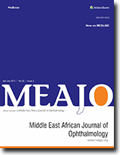
Middle East African Journal of Ophthalmology
Connecting researchers and practitioners for impactful insights.The Middle East African Journal of Ophthalmology is a distinguished publication dedicated to advancing knowledge in the field of ophthalmology, published by Wolters Kluwer Medknow Publications in India. With a robust focus on contributions that bridge the gap between clinical practices and scientific research, this journal serves as a crucial platform for researchers, practitioners, and students alike. Since its inception, it has consistently disseminated high-impact research, achieving notable recognition with a Q3 ranking in both Medicine (miscellaneous) and Ophthalmology categories as of 2023. Despite being a newer entrant into the scholarly landscape, it features an array of innovative articles, highlighting significant advancements and emerging trends in ocular health. Researchers may access a wealth of knowledge through its open access articles, promoting the dissemination of vital ophthalmic research that is relevant in both Middle Eastern and African contexts. By fostering collaboration and communication among professionals in the field, the Middle East African Journal of Ophthalmology is committed to championing excellence in eye care and elevating the standard of research applicable to global populations.
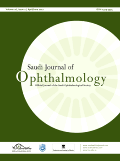
Saudi Journal of Ophthalmology
Enhancing Outcomes: Dedicated to the Science of Eye CareSaudi Journal of Ophthalmology, published by Wolters Kluwer Medknow Publications, stands as a crucial platform for the dissemination of innovative research and clinical practices in the field of ophthalmology. Since its inception in 2009, this journal has effectively contributed to the growing body of knowledge with a focus on addressing the diverse visual health challenges faced globally. With an ISSN of 1319-4534 and a E-ISSN of 2542-6680, the journal is indexed in Scopus, where it ranks in the Q3 category of ophthalmology, reflecting its commitment to quality research despite the competitive landscape. Situated in India, it provides a unique regional perspective while facilitating global discourse among researchers, practitioners, and students in ophthalmological sciences. Although it currently does not operate as an open-access journal, the Saudi Journal of Ophthalmology is essential for those aiming to expand their understanding of advancements in eye care, making it a valuable resource for professionals dedicated to enhancing patient outcomes through informed research and clinical practice.
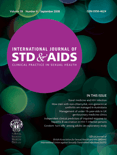
INTERNATIONAL JOURNAL OF STD & AIDS
Bridging gaps in understanding and treatment.INTERNATIONAL JOURNAL OF STD & AIDS is a prominent publication dedicated to advancing the understanding and treatment of sexually transmitted diseases and HIV/AIDS. Published by SAGE Publications Ltd, this esteemed journal has been contributing to the medical community since 1990, with a convergence of studies spanning to 2024. With its ISSN 0956-4624 and E-ISSN 1758-1052, the journal is recognized for its rigorous peer-reviewed research and has successfully positioned itself in the second quartile (Q2) of Dermatology and Public Health, alongside notable rankings in Infectious Diseases and Pharmacology. Currently based in the United Kingdom, this journal serves as a crucial resource for researchers, healthcare professionals, and students, providing a platform for innovative studies and critical reviews that address global health challenges. Although it does not offer Open Access, the journal continues to maintain its reputation as a vital reference point for those invested in the fields of dermatology, public health, and infectious diseases.
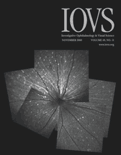
INVESTIGATIVE OPHTHALMOLOGY & VISUAL SCIENCE
Advancing the frontiers of vision science.Investigative Ophthalmology & Visual Science (IOVS) is a leading academic journal published by the Association for Research in Vision and Ophthalmology, dedicated to advancing the field of ophthalmology and visual science. With an impressive impact factor and ranking in the Q1 category for both Ophthalmology and Sensory Systems, IOVS is well-respected for disseminating cutting-edge research and innovative discoveries. Established in 1977, this Open Access journal allows for broad accessibility to pioneering studies, fostering collaboration among researchers, clinicians, and students. The journal has consistently maintained high visibility in the academic community, evidenced by its robust rankings in Scopus, including Rank #16 in Ophthalmology. As it continues to pave the way for future developments in the understanding and treatment of ocular diseases, IOVS serves as an invaluable resource for those immersed in the complex field of visual science.
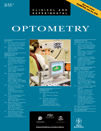
Clinical and Experimental Optometry
Driving the evolution of optometry through scholarly contributions.Clinical and Experimental Optometry, published by Taylor & Francis Ltd, is a distinguished journal dedicated to advancing the field of optometry and ophthalmology. With an impressive scope covering both clinical practices and experimental research, this journal serves as a vital resource for researchers, healthcare professionals, and students alike. Recognized in the Q2 category for Ophthalmology and Q1 category for Optometry in 2023, it underscores its significance in fostering innovative research and clinical knowledge. The journal has been in publication since 1986 and continues to accept contributions up until 2024, reflecting its ongoing commitment to disseminating high-quality scholarly work. With a Scopus ranking of 40 in Ophthalmology and 5 in Health Professions - Optometry, it is positioned among the leading journals in the field. Although not an open-access journal, it remains integral for anyone invested in the latest trends and findings in vision science, making it an essential part of the academic landscape in the UK and beyond.
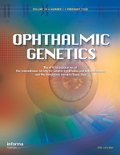
OPHTHALMIC GENETICS
Innovating Research at the Crossroads of Genetics and OphthalmologyOPHTHALMIC GENETICS is a distinguished journal published by TAYLOR & FRANCIS INC, specializing in the intersection of genetics and ophthalmology. Established in 1981, the journal has become a vital resource for researchers, clinicians, and students interested in the genetic aspects of eye diseases and disorders. Despite not being an Open Access journal, it maintains a commendable impact within the academic community, as reflected by its Q3 ranking in clinical genetics and Q2 rankings in both ophthalmology and pediatrics in 2023. With a robust focus on clinical applications, OPHTHALMIC GENETICS aims to provide a platform for innovative research and insights that drive advancements in patient care and understanding of genetic conditions affecting vision. The journal's international readership is supported by its timely publication of articles that bridge the gap between genetic research and practical ophthalmological applications.
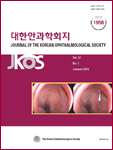
Journal of the Korean Ophthalmological Society
Pioneering Research for Better Eye HealthThe Journal of the Korean Ophthalmological Society, with ISSN 0378-6471 and E-ISSN 2092-9374, is a pivotal resource in the field of ophthalmology, published by the esteemed Korean Ophthalmological Society. Based in South Korea, this journal is committed to advancing knowledge in ophthalmology through the dissemination of research that spans both clinical and experimental studies. Despite its current Q4 ranking in the 2023 Ophthalmology category, it serves as a crucial platform for emerging scholars, practitioners, and students seeking to contribute to and learn from the latest developments in eye care. While the journal does not currently offer open access, it is dedicated to fostering scientific dialogue and innovation within the community. With convergence years from 2018 to 2024, the journal's focus on contemporary issues in ophthalmology positions it as a relevant and timely source of information, critical for those engaged in this dynamic field. For further inquiries, the journal can be contacted at their address in Seoul, South Korea: SKY 1004 BLDG 701, 50-1 Jungnim-ro, Jung-gu, 04508.